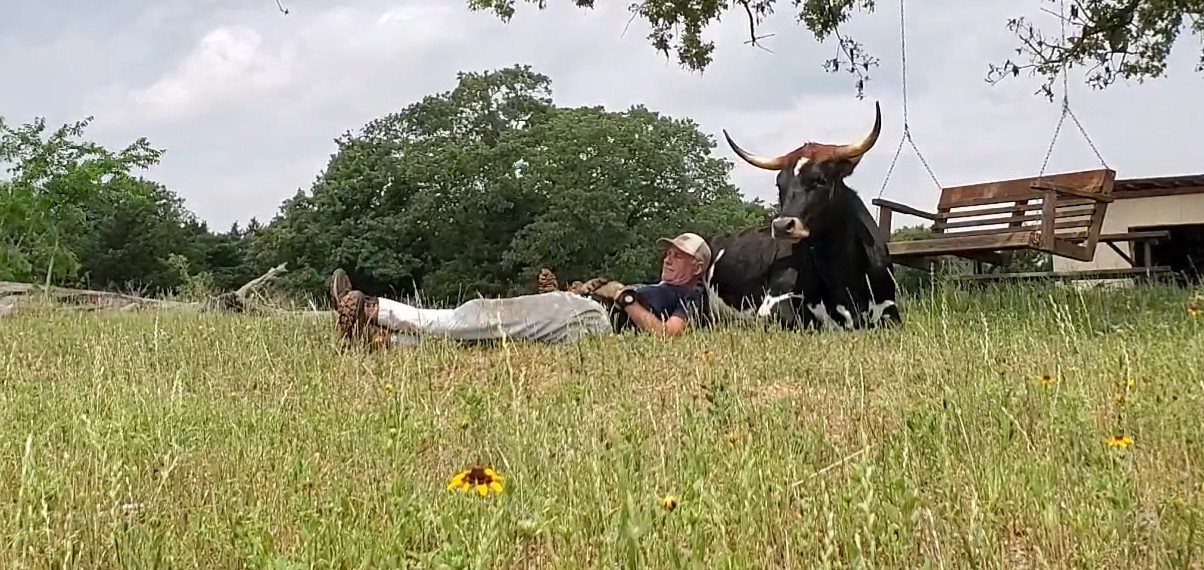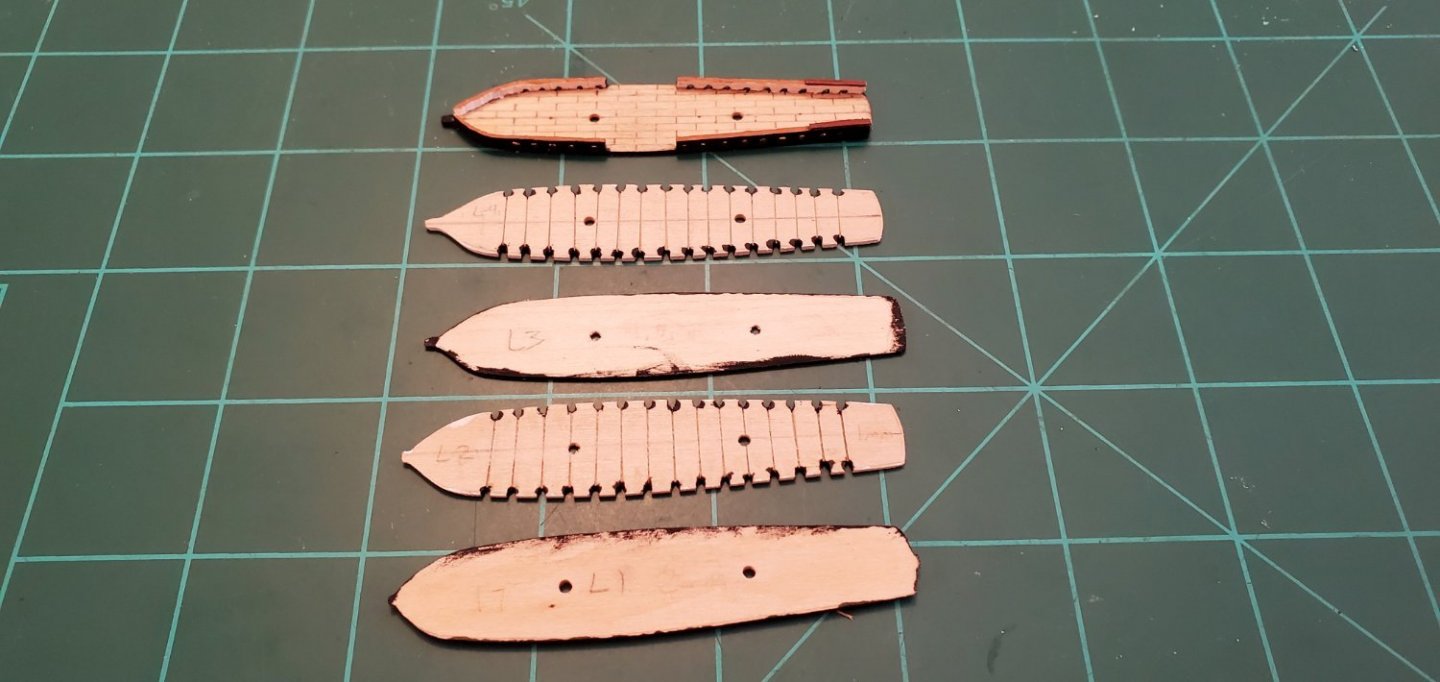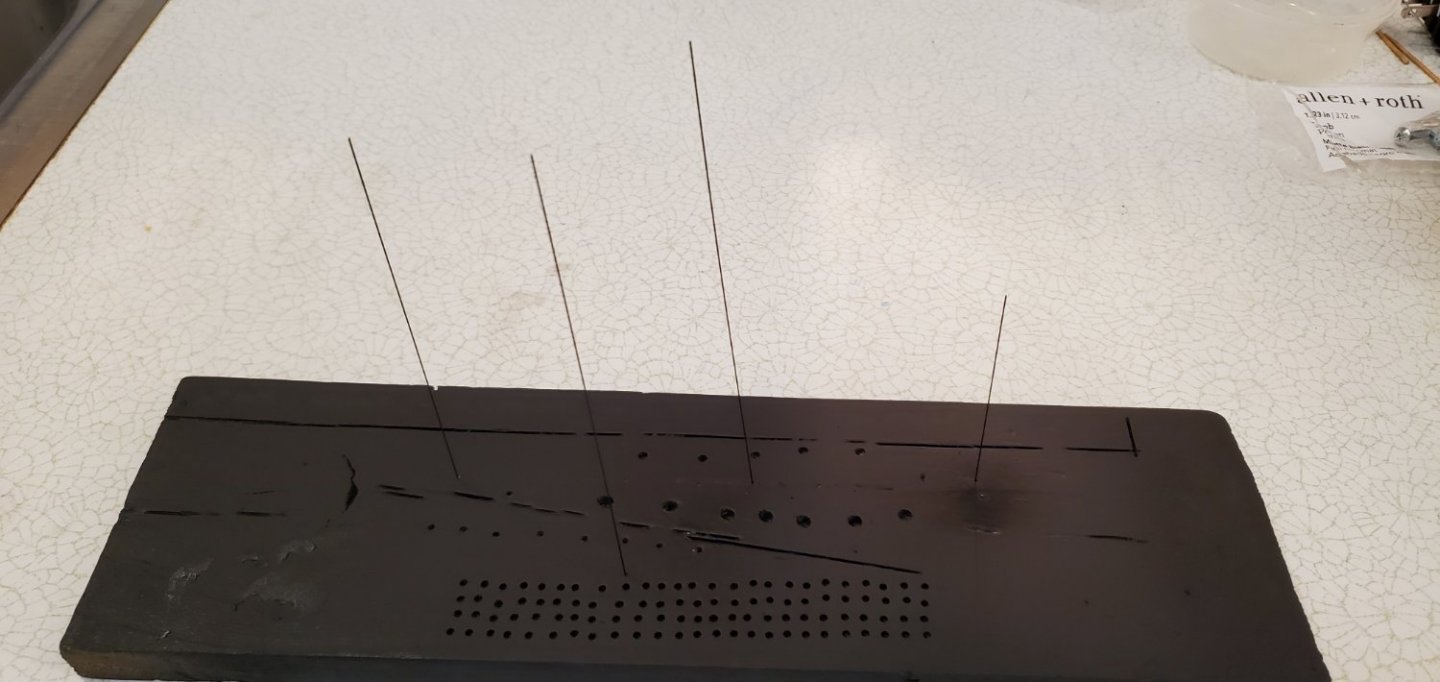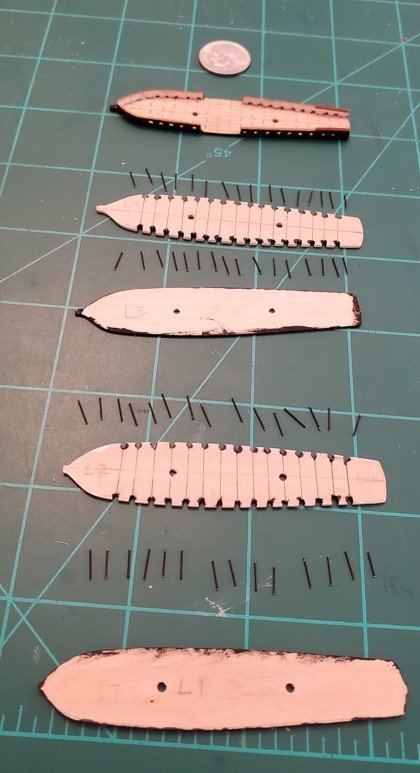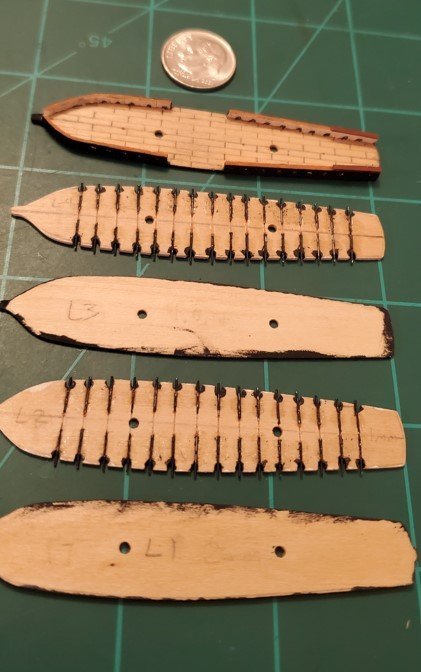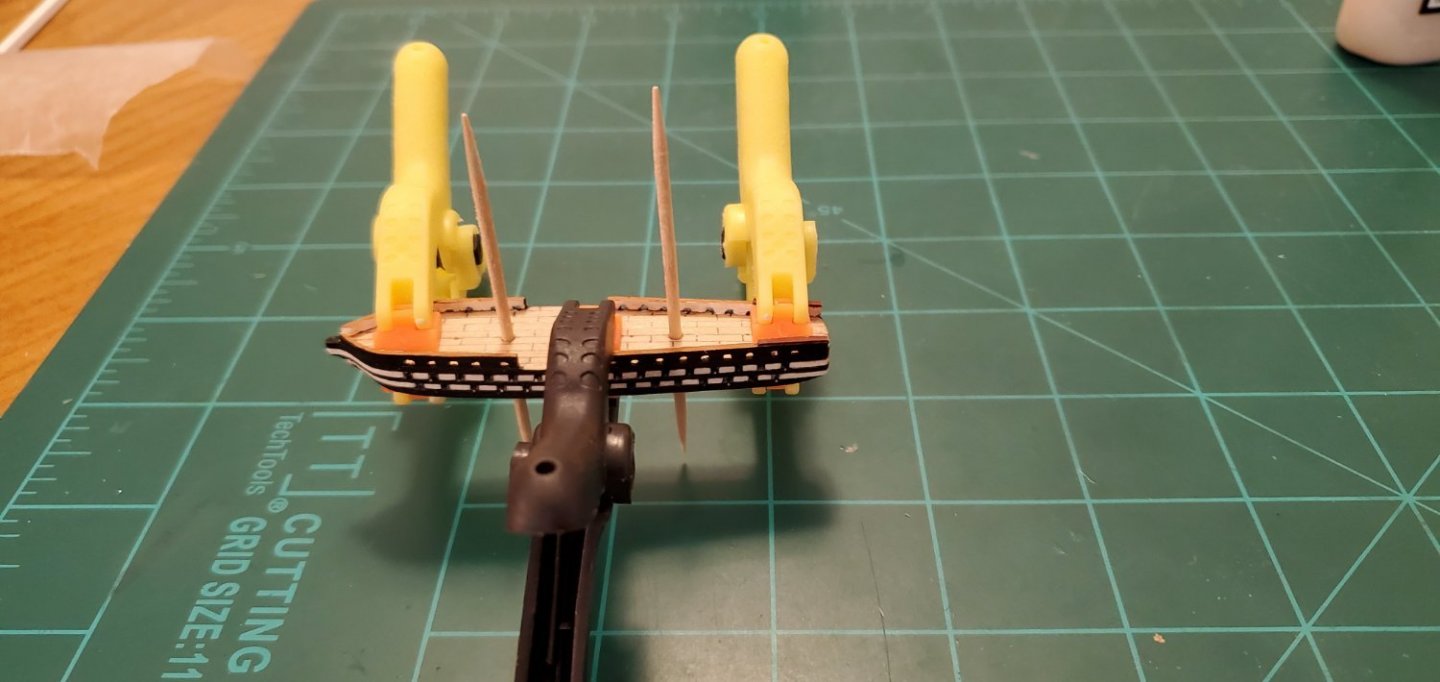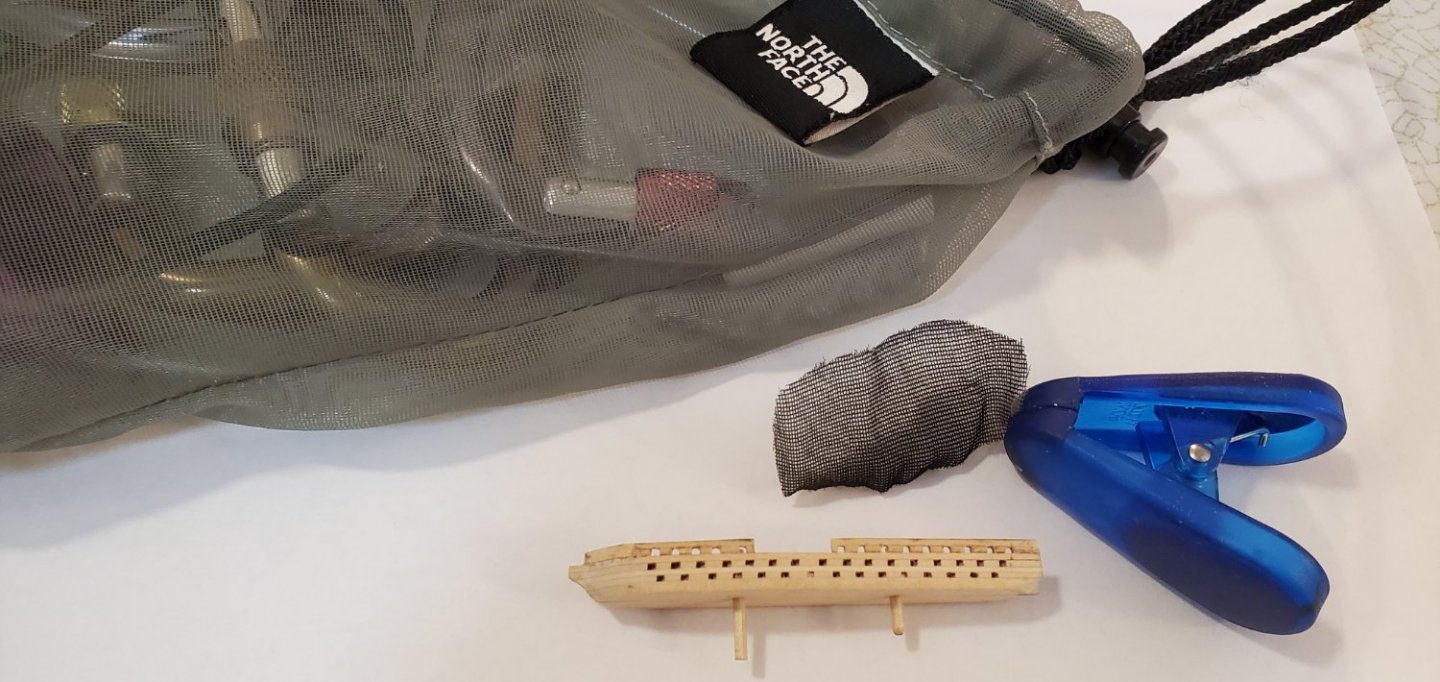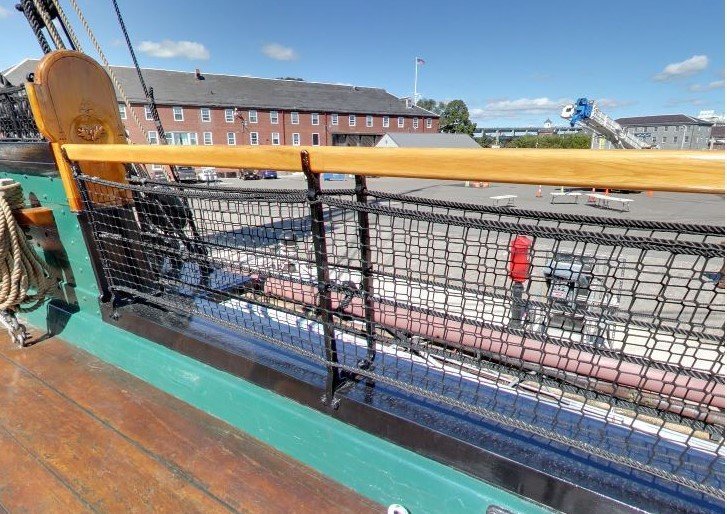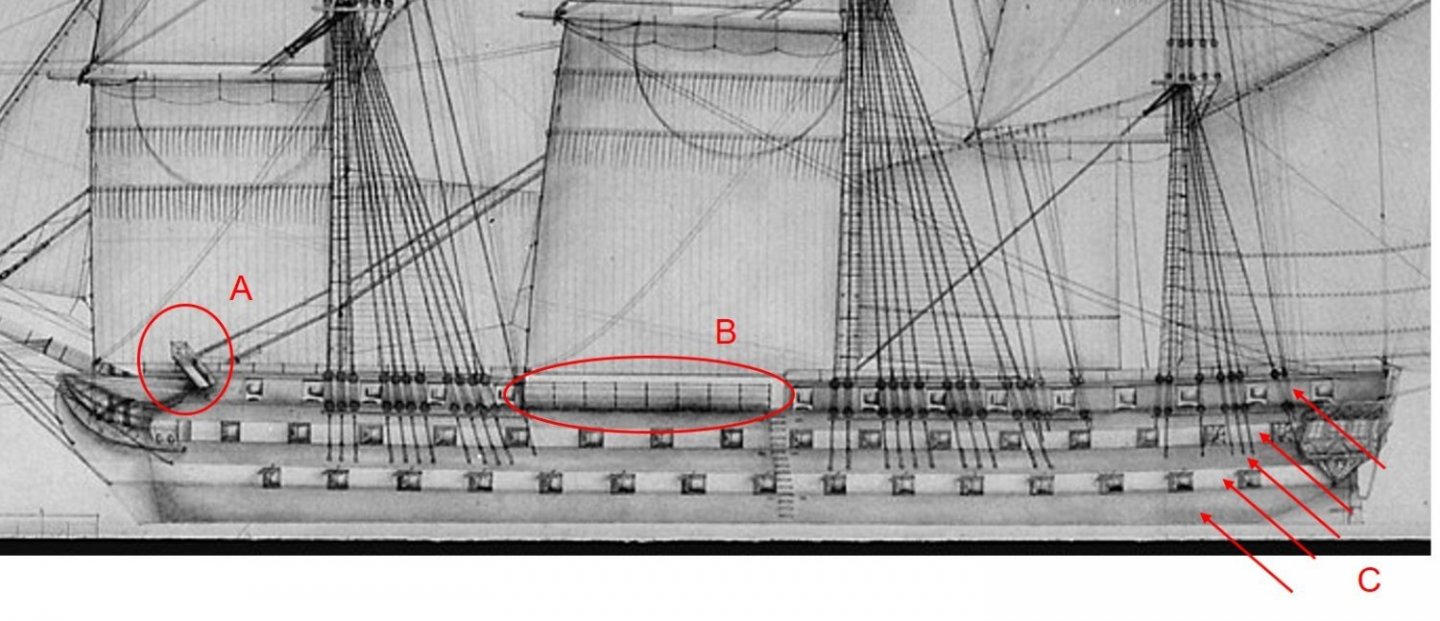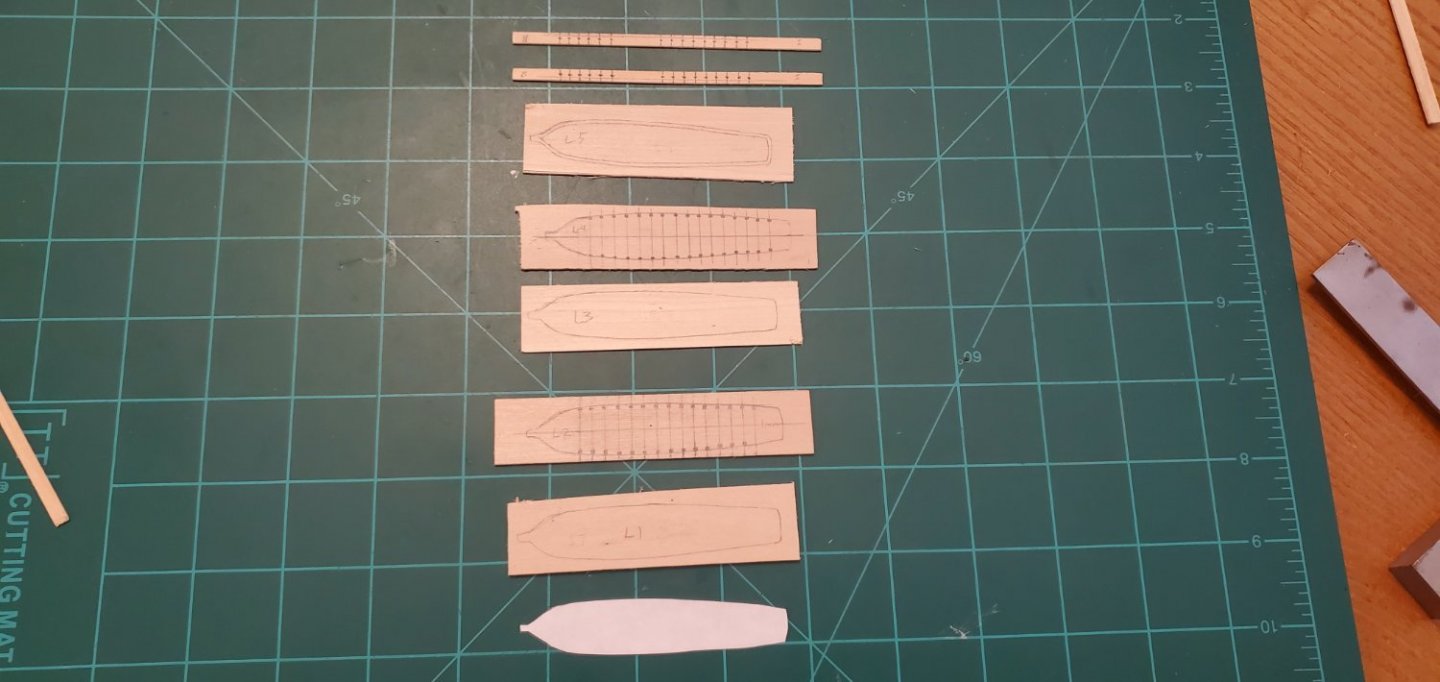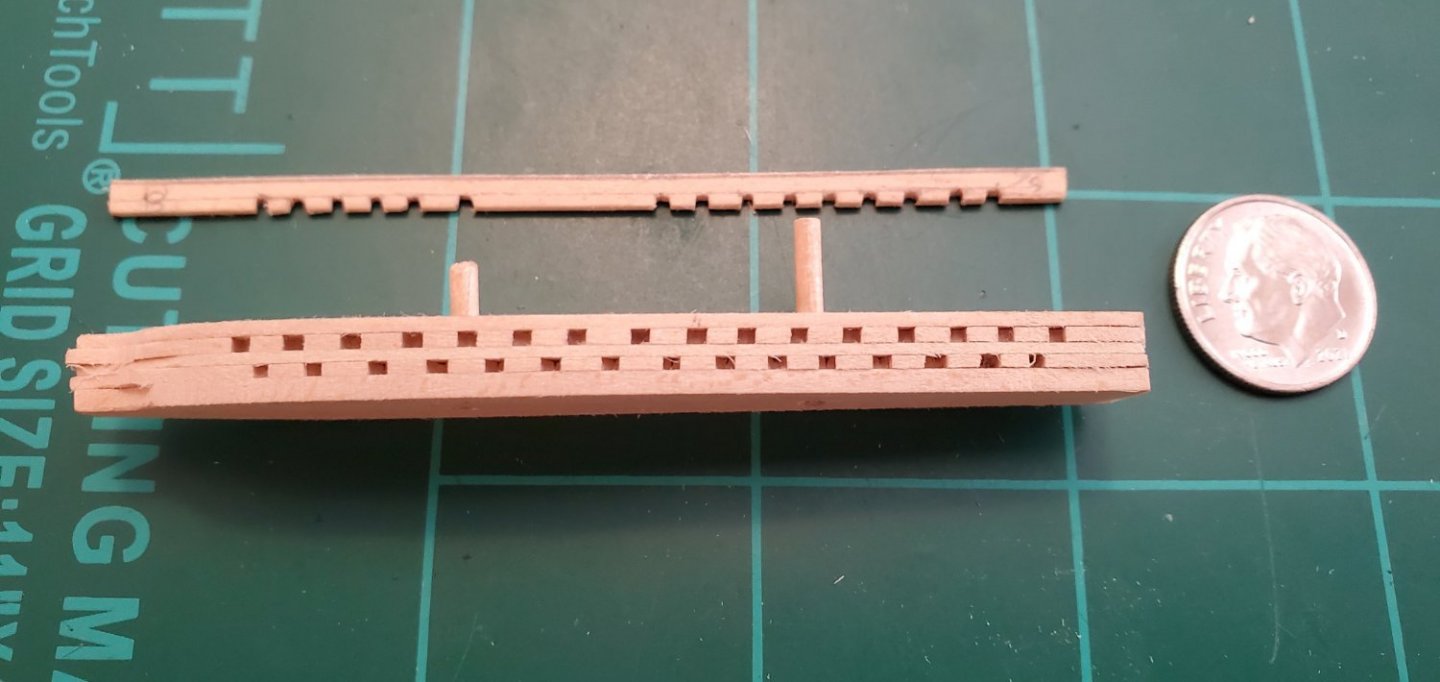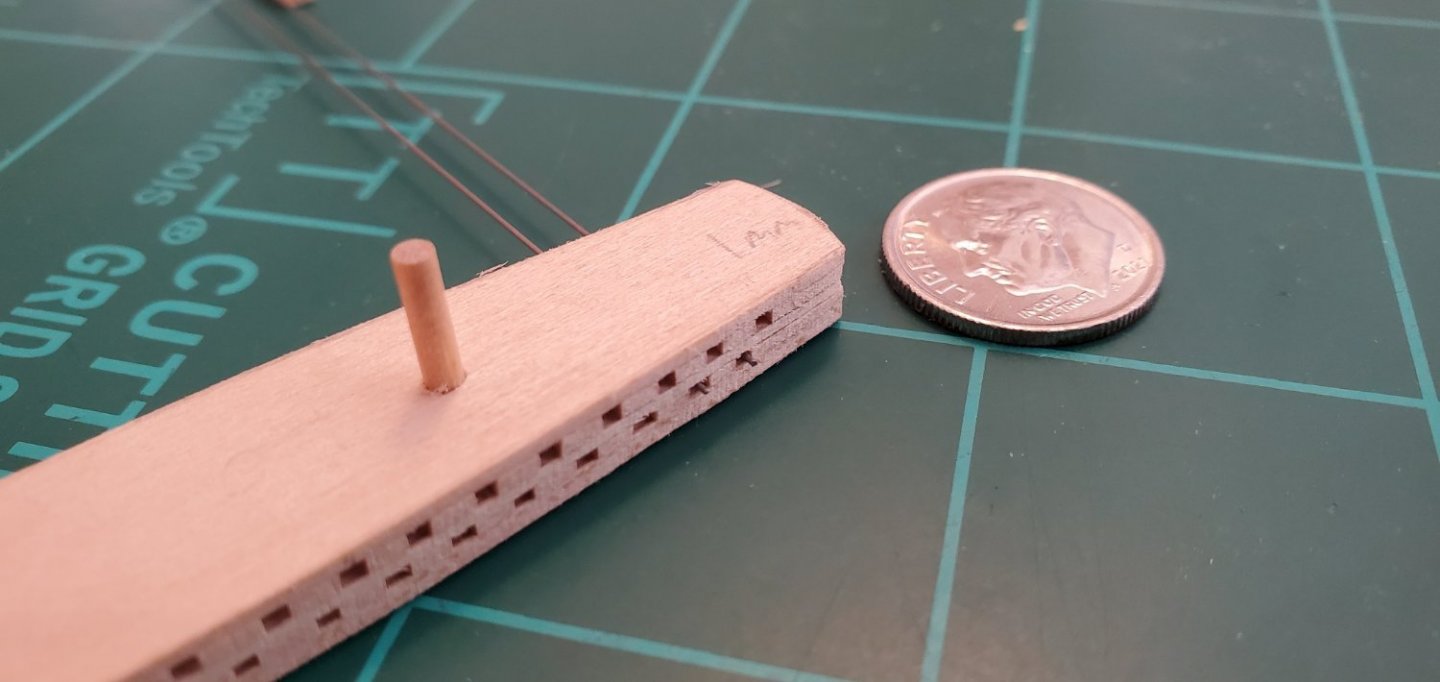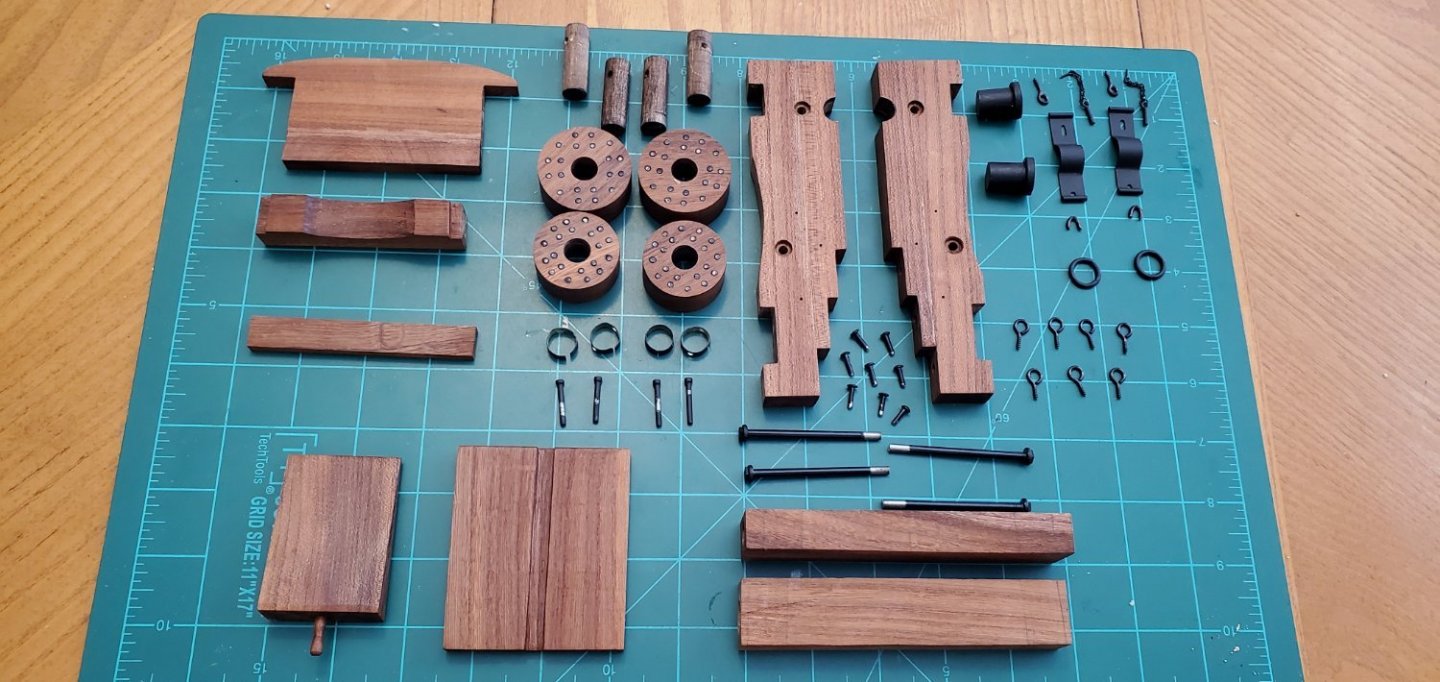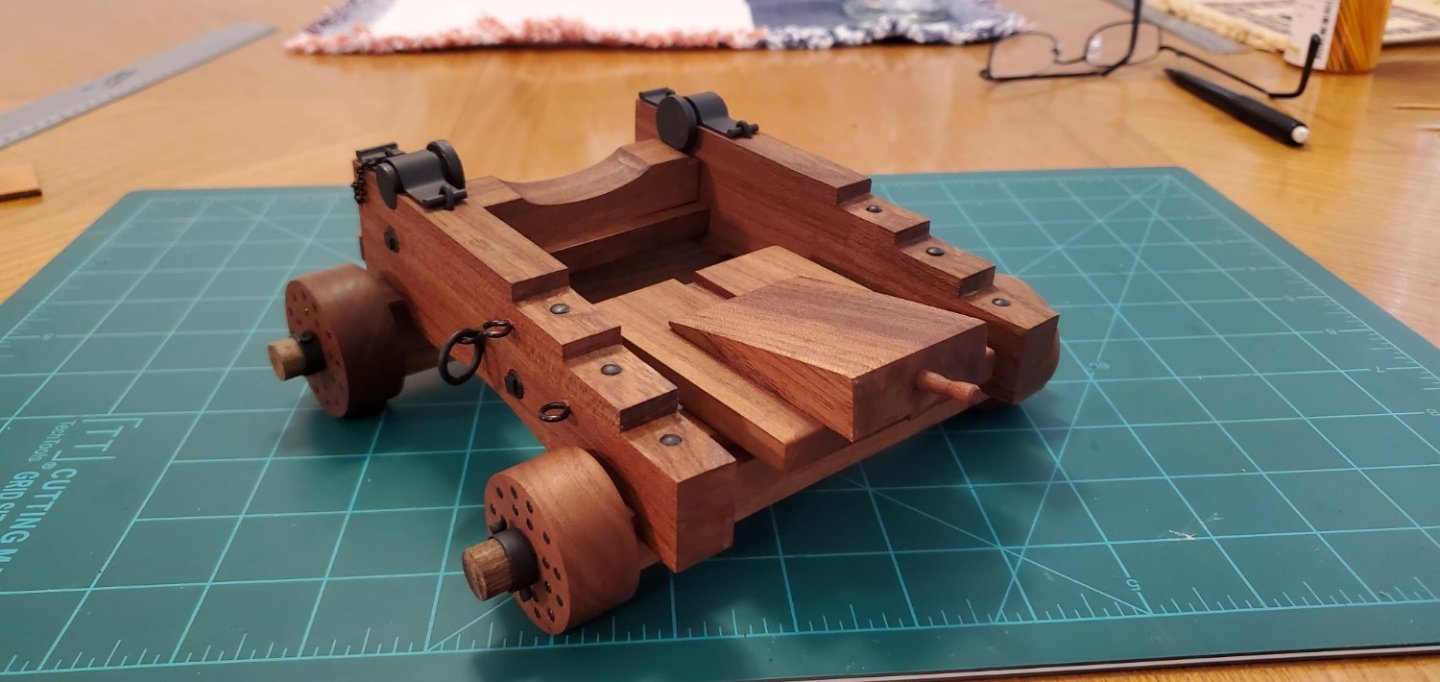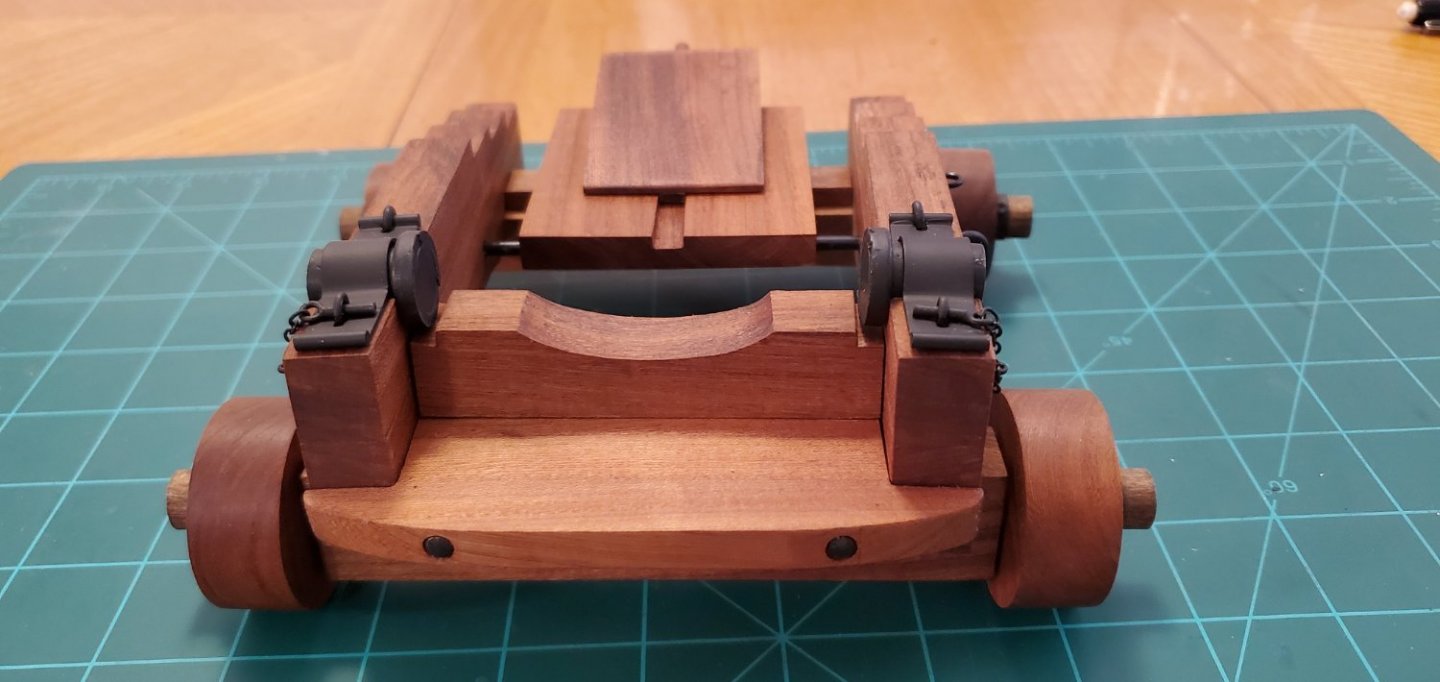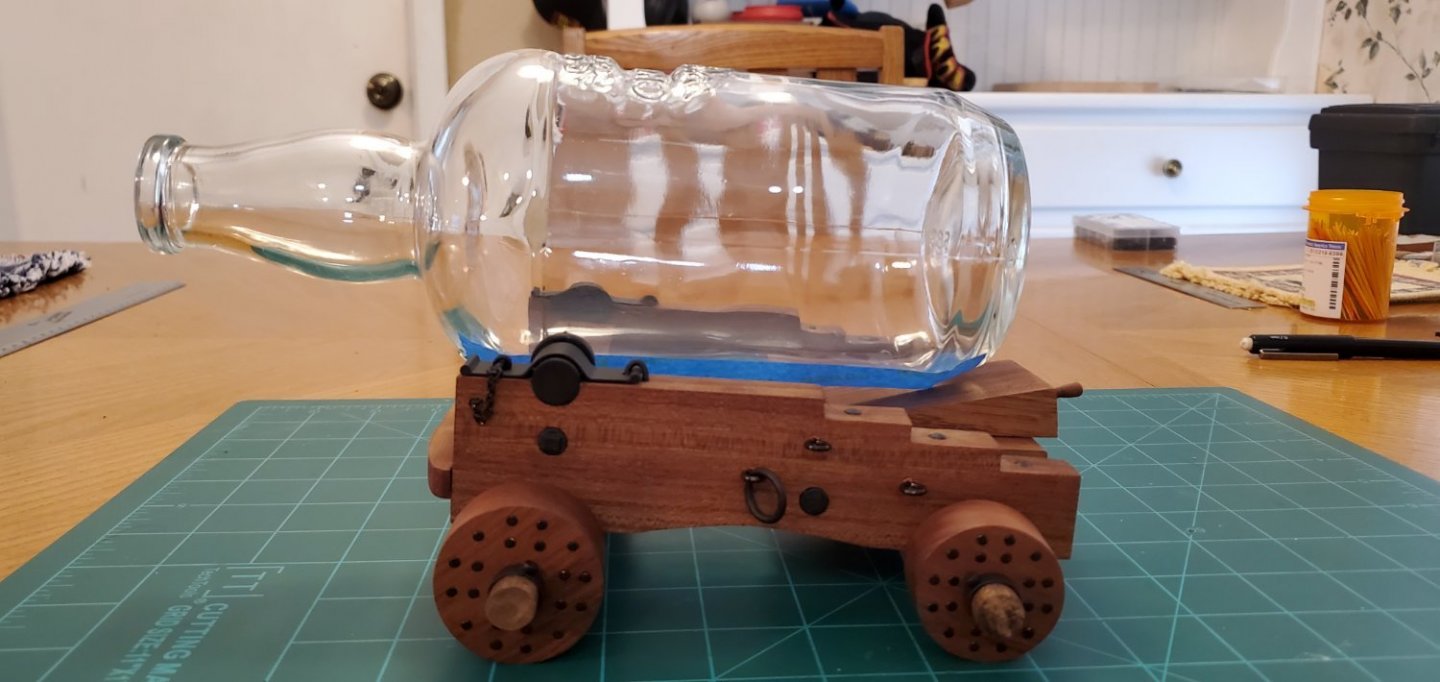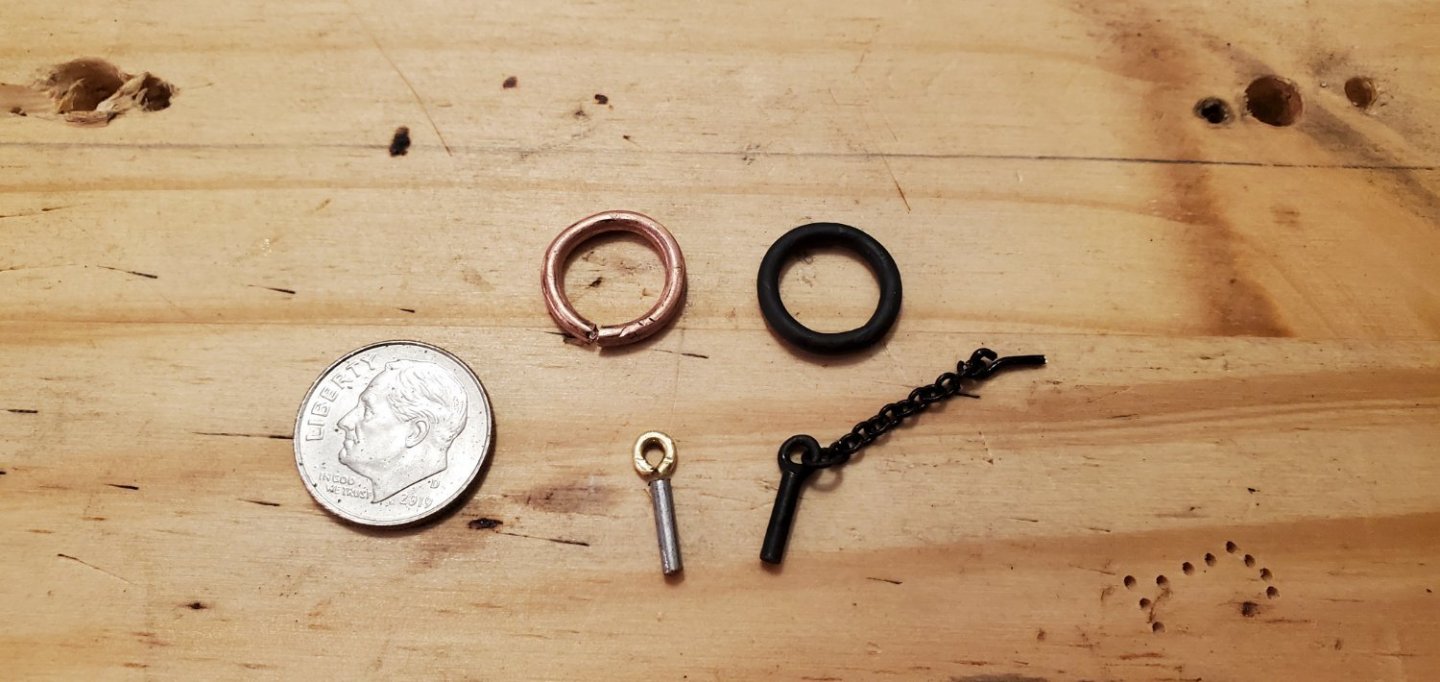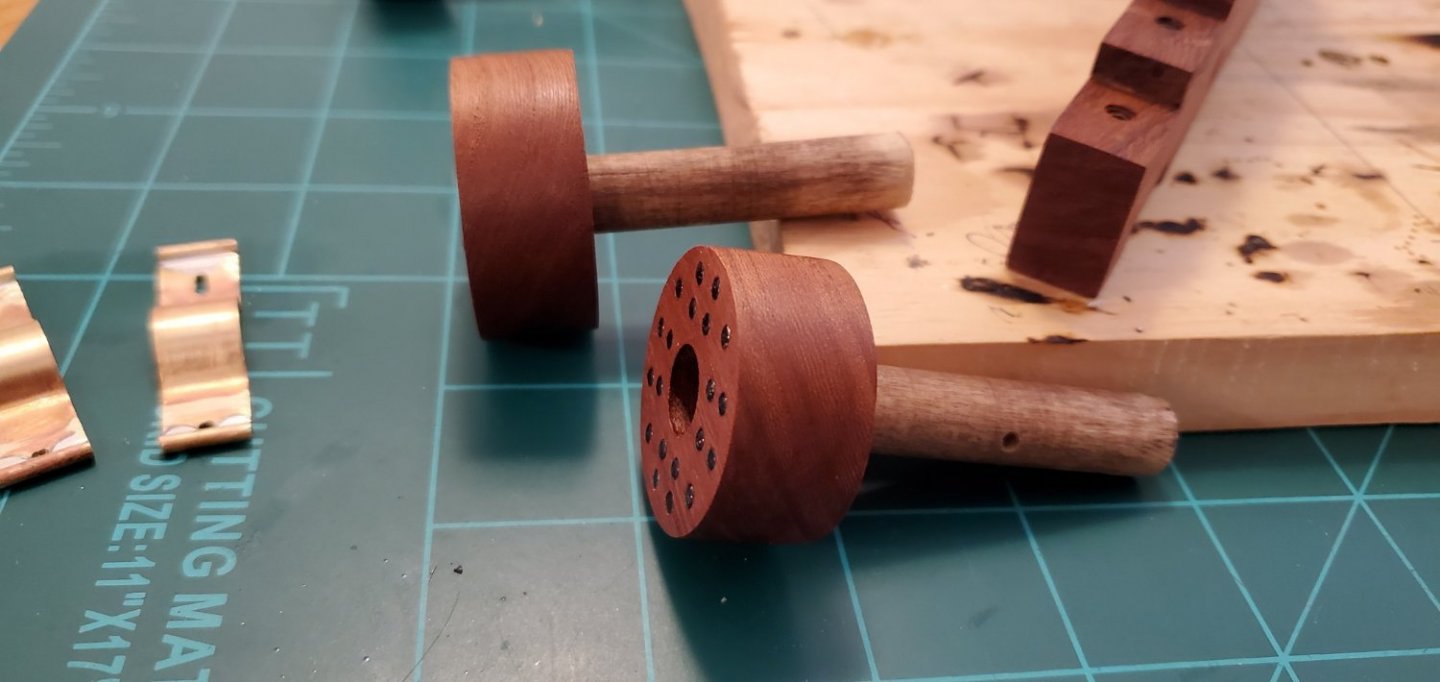-
Posts
1,956 -
Joined
-
Last visited
Content Type
Profiles
Forums
Gallery
Events
Everything posted by Glen McGuire
-
I got the hull layers painted so it's time to add cannons to the upper and lower gun decks and then squeeze the hull layers together. The pics show the construction process: 1. Five hull layers ready for assembly 2. Cannons painted (.015" music wire) 3. Cannons cut down to size 4. Cannons in place 5. Hull layers glued and clamped Those cannons are hard to see in that last pic, but you gotta trust me that they are in there!
- 177 replies
-
- Independence
- bottle
-
(and 1 more)
Tagged with:
-
Hey Brian, welcome aboard from a fellow Texan!
-
Thank you, Ian. Thanks, Keith. The hull and bulwarks are basswood pieces. Each piece is 1mm thick except for the bottom layer which is 2mm. That will give me some wiggle room if the ship needs to go on a diet to fit inside the bottle later. That's been a problem for me on previous builds. So I am determined to do a better job of planning during the construction phase.
- 177 replies
-
- Independence
- bottle
-
(and 1 more)
Tagged with:
-
Thanks, Mike. I tried to get them all the same size and as square as possible. Not perfect, but not too bad. The layers are still just dry-fitted so I can disassemble and paint the alternating black and white scheme. I'm still not sure what I'm doing with the prow.
- 177 replies
-
- Independence
- bottle
-
(and 1 more)
Tagged with:
-
Thanks for the guidance, Mark. I went scrounging around the garage and found a finely woven mesh bag. And since nothing is else matters when you need just the right thing for a model, I cut off a small piece of the bag and gave it a light dusting of black spray paint. I think it will work perfectly.
- 177 replies
-
- Independence
- bottle
-
(and 1 more)
Tagged with:
-

How many kits do you have on the go at the moment?
Glen McGuire replied to CaptnBirdseye's topic in Wood ship model kits
Nope! I'm right there with you, Dave. One at a time. I have several requests/suggested ideas for SIBs piling up but I won't start on a new one till I finish the one I'm working on. -
Thanks, Mark. I get A & C now. Are you talking about something like this below? I found this picture from a post by _SalD_ under a topic called "Hammock Netting Question". Supposed to be from the current Constitution.
- 177 replies
-
- Independence
- bottle
-
(and 1 more)
Tagged with:
-
I have some questions I'm hoping someone can help with. This sail plan picture of the original 1814 Independence is the only thing I've got to build from and there are 3 things I'm not sure of (circled below). A - Is that an anchor? If not, any idea what it is? B - It looks like there's a gap in the bulwark and some kind of fence? Any idea what that is? C - Obviously it's a black and white pic, but it looks like there is an alternating color pattern between the gun deck levels and the wales. Is it likely that the color scheme would alternate black and white? If not, what would it probably be? Any insight/opinion y'all could provide would be greatly appreciated.
- 177 replies
-
- Independence
- bottle
-
(and 1 more)
Tagged with:
-
Fingers in ears.. LA LA LA LA LA LA LA LA LA LA LA...
- 177 replies
-
- Independence
- bottle
-
(and 1 more)
Tagged with:
-
OMG!!! Is there a moderator for this website that I can report y'all to for modeler abuse? Someone help me, PLEASE!!!!
- 177 replies
-
- Independence
- bottle
-
(and 1 more)
Tagged with:
-
Thanks, Keith! I hesitate to even mention the cannons because you and my son will start telling me how I need to have smoke coming out of them!
- 177 replies
-
- Independence
- bottle
-
(and 1 more)
Tagged with:
-
From the cannon yard to the ship yard. I’ve been struggling all week with how to make this hull with all the 1mm x 1mm gun ports. My first plan was to build the hull, then drill out the gun ports. After a trial run, it looked awful with round gun ports. And the holes are just too tiny to square off after drilling. So after a few more failed ideas, I settled on a lamination plan with alternating layers of 1mm thick basswood. That allowed me to carve out each gun port individually in a square shape (as best I could at this size anyway). The hull in the 2nd pic is not glued yet – it’s just held together by the dowels sticking out of the top layer. The last pic shows a couple of test cannons in place (.015” music wire). I cut a groove into the gun port layer connecting ports on each side of the ship and inserted the wire all the way thru. That will allow me to snip off each cannon at the appropriate length when ready. So now I’ve got to shape the hull, disassemble, paint the layers, reassemble, secure the bulwarks, then add the cannons. Still some details to flesh out but I think this is going to work. Maybe.
- 177 replies
-
- Independence
- bottle
-
(and 1 more)
Tagged with:
-
I love it! Unique idea and very well done.
- 3,560 replies
-
- clipper
- hull model
-
(and 2 more)
Tagged with:
-
I also had a near heart attack moment during final assembly. Somehow I managed to drop a dime-sized blob of epoxy on the display-side of the carriage right between the trunion and the breech ring. And somehow I didn't notice it till the epoxy was almost dry. After alarming the entire neighborhood with my shrieks of anger and panic, I scraped off as much of the epoxy as I could with my fingernail, then spent about 20 minutes going over the spot very lightly with 220 sand paper trying not to take off any more of the wood surface. I finally got to a point where I thought there was no epoxy left, then gave the whole side a light rub with the tung oil. Afterwards, I could not tell any difference. OMG, what a relief.
- 177 replies
-
- Independence
- bottle
-
(and 1 more)
Tagged with:
-
Thanks, Mike. I tried the Jax Pewter Black stuff but it kept rubbing off. I tried brushing it on like others suggest as well as multiple coats but still could not get it to work well. So I ended up rubbing it all off and just spray painting with Rust-oleum flat black.
- 177 replies
-
- Independence
- bottle
-
(and 1 more)
Tagged with:
-
Thank you, Keith. That was certainly a change of pace working at a roughly 1/12 scale instead of the usual 1/500! A cannon model? Hmmmmm. That is an interesting idea. I may have to put that on the list. It would certainly be easier the 2nd time around. I screwed up so many things along the way while building this one it's not even funny.
- 177 replies
-
- Independence
- bottle
-
(and 1 more)
Tagged with:
-
The carriage is now complete with the exception of the rigging. I’ll “tackle” that after finishing the ship. 🙄 The first pic shows all the pieces and parts of the carriage before assembly.
- 177 replies
-
- Independence
- bottle
-
(and 1 more)
Tagged with:
-
Finished making the last pieces of carriage hardware. For the breeching ringbolt I took a piece of copper wire, wrapped it around a dowel rod and soldered the ends. For the capsquare key I took a small brass rod, bent it into a circle around a small nail, and soldered it to part of a small finishing nail. The 2nd pic shows all the completed capsquare hardware.
- 177 replies
-
- Independence
- bottle
-
(and 1 more)
Tagged with:
-
@Deperdussin1910 Thanks for the comment. I do find the list very interesting. When Chappelle said the Independence was the first ship of the line commissioned by the US Navy, I assumed it was the first US ship of the line. But maybe he was alluding to the fact that the Dept of the Navy did not officially exist until 1794 and the Independence was the first one commissioned after that. The history is always fascinating.
- 177 replies
-
- Independence
- bottle
-
(and 1 more)
Tagged with:
-
Thanks, Mike. Yes, I did put a touch on the end grain of the carriage sides. It was going to be a hair light without it and a hair dark with it. It was not going to be perfect either way, so I went with the slight darkening.
- 177 replies
-
- Independence
- bottle
-
(and 1 more)
Tagged with:
-
File this under "Questions I should have asked before doing something." The end grain is really exposed with the wheels and as soon as I applied the tung oil, I noticed it was darker that the long grain. So I buffed it quickly. Of course since I did it on 1 wheel I had to do it on all 4. It ended up being a touch darker but I can live with it. Lesson learned - I tested on the long grain but didn't think to test on the end grain. Thanks for your insight. I like the way you tested and laid out all the different shades of stain in your Pegasus build. In hindsight, I think varnish might have been the way to go, but I will definitely test all sides from now on!
- 177 replies
-
- Independence
- bottle
-
(and 1 more)
Tagged with:
-
OMG Joe! I've got 4 pieces of rail of various sizes lying around (along with a few tie-plates) and it's unbelievable how many things I use them for. Next to duct tape, they are about the handiest thing in my garage! Hey Grant, understood! As I mentioned in the first post, I was trying to avoid my own list of "other priorities" when I began this project! Still very much looking forward to when you are able to start your Amati Hannah. Thanks, Mike. I actually added a light coat of tung oil to the wood before this last set of pictures. It darkened it just a shade and gave it what I think is a richer tone. To my eye, the color is a bit darker than the picture so I'm not sure I'm not sure if I want to do anything more that would change it too much. How do you finish wood with this type of natural color? I've got minimal experience with wood-working like this so any advice is much appreciated. I actually looked for some Kunos oil that @gjdale mentions in his Capstan project but could not find any around here.
- 177 replies
-
- Independence
- bottle
-
(and 1 more)
Tagged with:
About us
Modelshipworld - Advancing Ship Modeling through Research
SSL Secured
Your security is important for us so this Website is SSL-Secured
NRG Mailing Address
Nautical Research Guild
237 South Lincoln Street
Westmont IL, 60559-1917
Model Ship World ® and the MSW logo are Registered Trademarks, and belong to the Nautical Research Guild (United States Patent and Trademark Office: No. 6,929,264 & No. 6,929,274, registered Dec. 20, 2022)
Helpful Links
About the NRG
If you enjoy building ship models that are historically accurate as well as beautiful, then The Nautical Research Guild (NRG) is just right for you.
The Guild is a non-profit educational organization whose mission is to “Advance Ship Modeling Through Research”. We provide support to our members in their efforts to raise the quality of their model ships.
The Nautical Research Guild has published our world-renowned quarterly magazine, The Nautical Research Journal, since 1955. The pages of the Journal are full of articles by accomplished ship modelers who show you how they create those exquisite details on their models, and by maritime historians who show you the correct details to build. The Journal is available in both print and digital editions. Go to the NRG web site (www.thenrg.org) to download a complimentary digital copy of the Journal. The NRG also publishes plan sets, books and compilations of back issues of the Journal and the former Ships in Scale and Model Ship Builder magazines.

